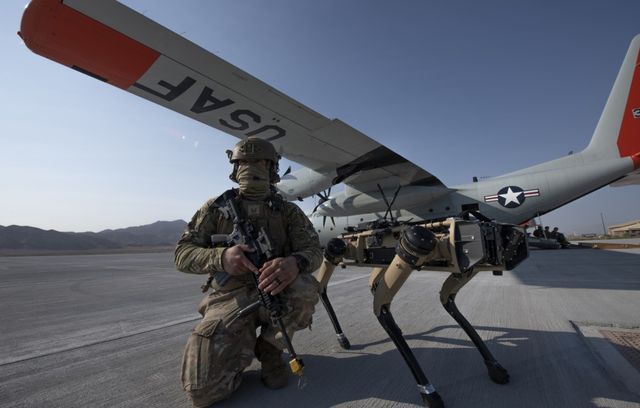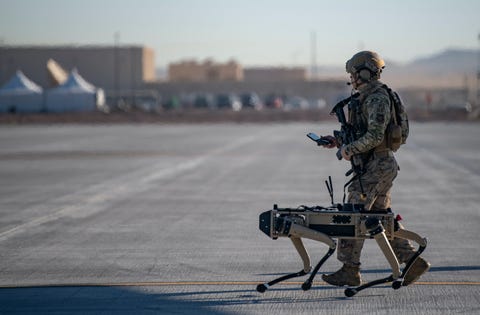The Future of Mechanized, Robotic Warfare
"We can see them in war zones, working with bombs, scouting, targeting, probably in 2023.""These can really become a war fighter's best friend.""[The military feels the robots have the potential to be used in a] contingency, disaster or deployed environment."Jiren Parikh, CEO, Ghost Robotics"A core design principle for our legged robots is reduced mechanical complexity when compared to other legged robots, and even traditional wheeled-tracked UGVs [unmanned ground vehicles]."Ghost Robotics website
 |
| U.S. Air Force |
The dog-sized machines produced by Ghost Robotics are equipped with onboard cameras and sensors. Their purpose is to monitor for the presence of intruders along the perimeter of an army base. Capable of trotting along for as long as 7-1/2 hours before requiring a recharge, the machines, not intended for the replacement of real military dogs, can be assembled in 15 minutes, and limbs that become damaged replaced even more expeditiously.
The machines come equipped with Wi-Fi and 4G LTE to enable live information sent to its operator. Over one hundred of these robot dogs have been shipped in 2020, with the intention to send off over 250 in 2021. The robots represent part of the ambitions by the military to achieve an Advanced Battle Management System using a network of innovations like artificial intelligence and robotics for the purpose of detecting and defending against threats.
These high-tech canines labelled Vision 60 are seen as a security enhancement, forming part of a plan to replace stationary surveillance cameras at Tyndall Air Force Base in Florida. For their part, their manufacturer, Ghost Robotics. contracted by the U.S. Department of Defence, looks toward a future scenario where the machines surpass merely patrolling duties. A step forward would relate to introducing robot dogs to conflict zones.
Put into use, the robots' presence will enable humans in the military to focus on other, less mundane tasks. Philadelphia-based Ghost Robotics, founded in 2015, designed the drone with four legs as an alternative, to "feel the world". Its mechanical legs allow it to retain its equilibrium in balance while prowling through water, tall grass and like terrain.
 |
Sub-zero temperatures are no problem, since the computerized 'dogs' are able to operate in such conditions; produced to move just as animals do, they are able to climb stairs, run and turn themselves into an upright position if knocked over or tumbled. Motors control the legs and based on alterations in ground pressure, adjust accordingly. That reliance on motors for navigation purposes makes Ghost Robotics more flexible than Boston Dynamics' devices with their use of sensors.
Appearing for a demonstration at Tyndall base last month, the robot canines operated with the use of a remote control. Programmed for a patrol path, they roam semi-autonomously, their handlers capable of controlling them through virtual-reality headsets if required. Defenders who would otherwise be on patrol can now focus on training, security and overall situational awareness on the base, with the presence of the military-grade canines deployed to patrolling.
The canine robots have bomb-disabling applications, but at the present time there are no immediate plans to weaponize them. Tyndall represents the first military base in the U.S. to integrate the robots on a full-time basis. The Australian military in 2019 experimented to assess how it could leverage the robots in the "future of land warfare" in a collaboration between Ghost Robotics and the Aussie army.
 |
Labels: Australia, Base Patrol, Canine Robots, Military, Robotics, United States

<< Home